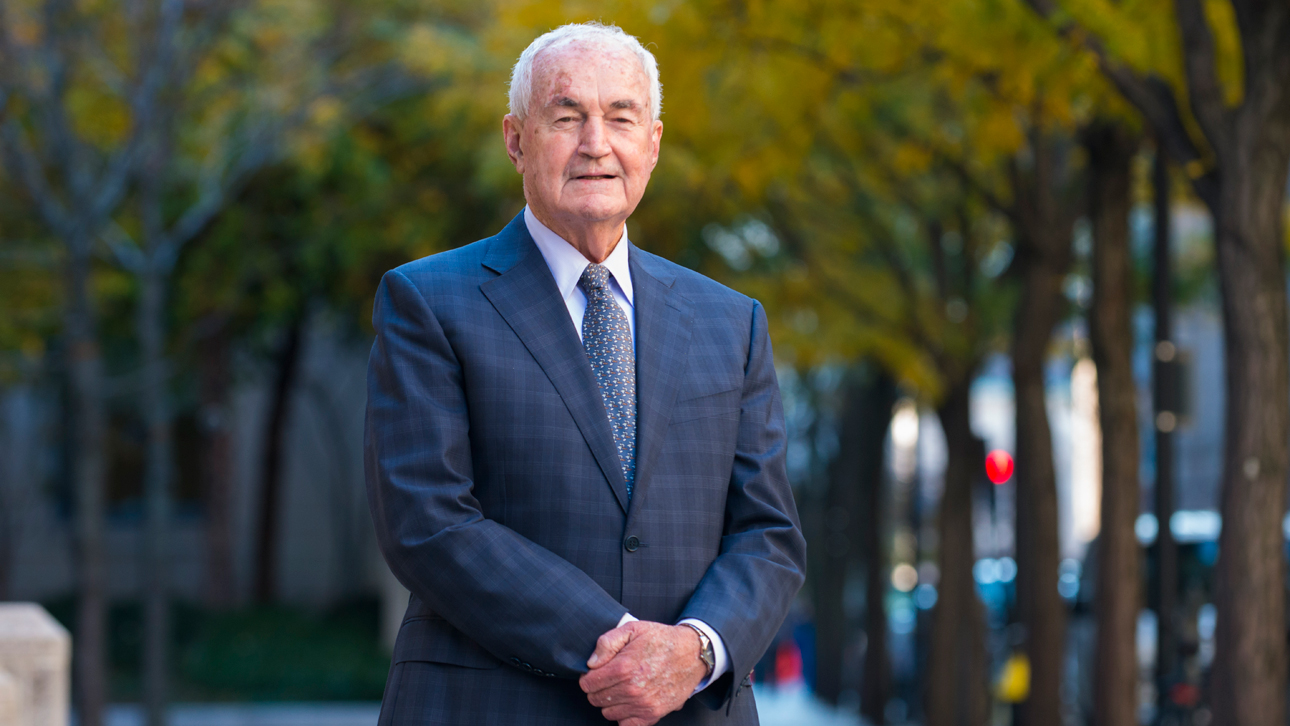Joseph E. Corcoran ’59, H’09, a compassionate and visionary developer who led a national resurgence of mixed-income housing—and who generously shared talent and treasure with his alma mater—died on June 3. Since 2015, a center established in his name at the Carroll School of Management has been teaching Boston College students to go forth and do likewise. They’re carrying on his legacy, which has evolved through coursework, field projects, case studies, summer internships, service learning, public lectures, and other offerings of the Joseph E. Corcoran Center for Real Estate and Urban Action. Many are familiar with Corcoran’s reputation and his work. Fewer know that he taught a course that continues to capture his sense of mission as well as his way of planting seeds of change while forging breakthrough projects. What follows is a story interspersed with oral-history-style reflections, recounting what Corcoran did for—and with—urban dwellers, and how he brought it all into the classroom at Boston College.
Columbia Point was a symbol of urban decay and failed public housing before Joseph E. Corcoran ’59 spearheaded its resurgence as a thriving mixed-income development. He did it by ignoring the naysayers and including the low-income tenants as vital partners in the project.
To teach a new generation of aspiring developers what he had learned over a career of such socially-conscious successes, Corcoran—the founder, president, and CEO of Corcoran Jennison Companies—started teaching the Real Estate and Urban Action course at Boston College ten years ago this fall. And five years ago this past spring, the course expanded into the Joseph E. Corcoran Center for Real Estate and Urban Action at the Carroll School of Management.
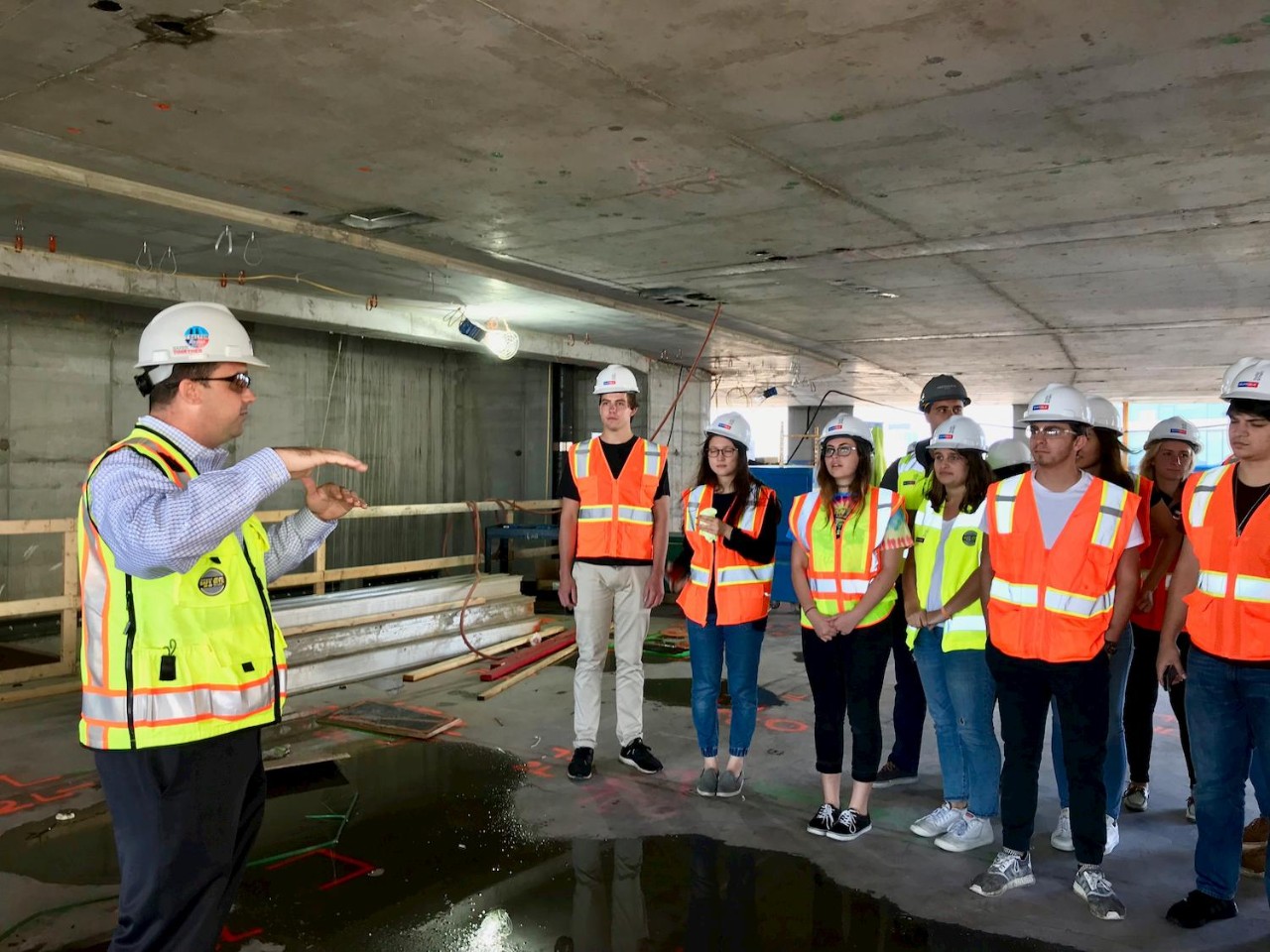
The Fall 2017 Real Estate and Urban Action class on a field trip to a project site in downtown Boston.
Through its courses and other programs, the center aims to inspire students to reject the conventional planning and real estate mindsets that would simply shunt the poor into isolated warehouses while flipping decent homes and erecting towers for the wealthy. “In every class, we reinforce that if you do these projects, they have to be mixed-income, they have to be community-led,” said Neil McCullagh ’91, who now teaches the course and is the executive director of the center.
“That’s what Joe did at Columbia Point,” McCullagh added. “He proved you can do a big project in partnership with the residents.”
And that starts with hearing what the experts—the people who live in the community—have to say. “I would argue,” said McCullagh, “that one of the single biggest skills we can teach students is how to listen.”
Putting a failure out to pasture
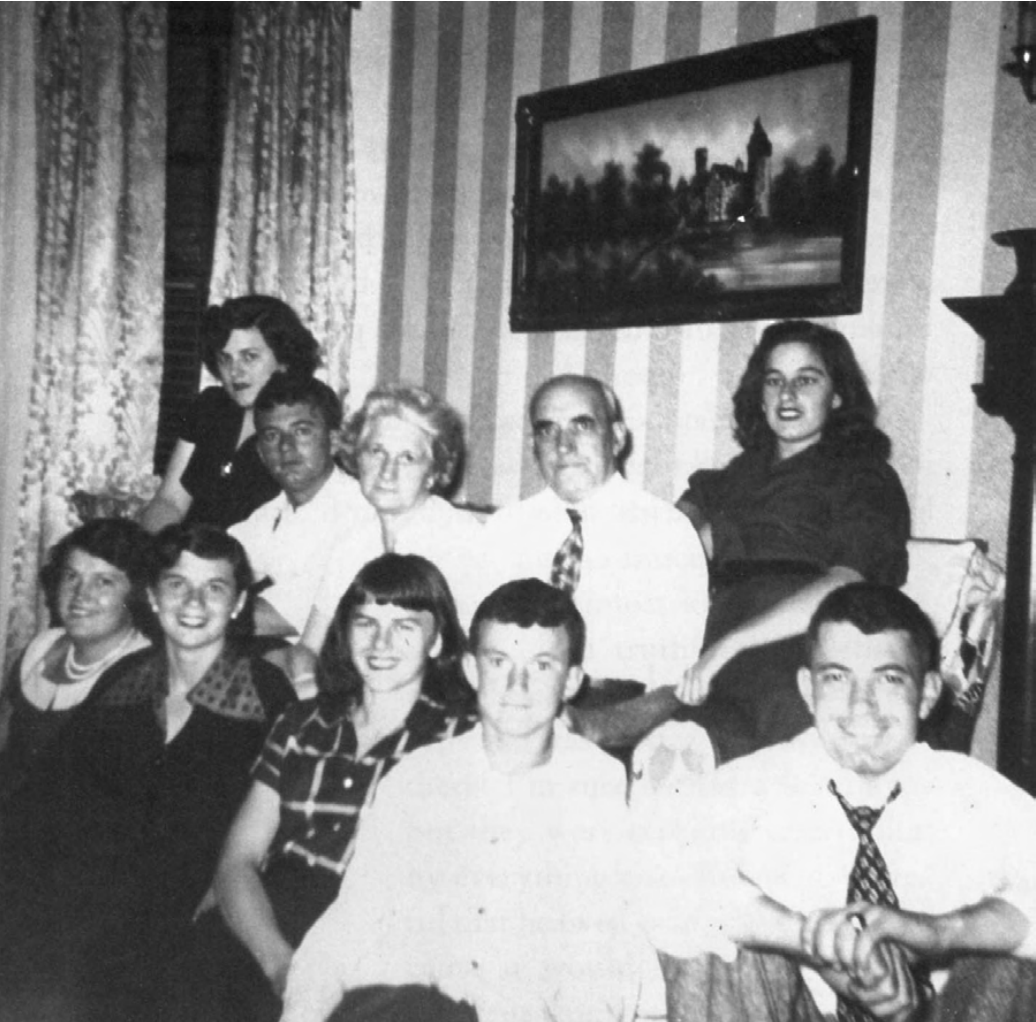
A Corcoran family gathering in their home in Dorchester. Back row, from left: Mary, Leo, mother Mary, father John, and Bernadette. Front row, from left: Theresa, Claire, Frannie, Joe, and Jack. Photo via “Wasn’t That a Time! A Corcoran Family Memoir” by Joseph Corcoran
The genesis of the course, the center, and Corcoran’s career lies in his upbringing in Dorchester, Boston’s largest neighborhood. The youngest of eight children of immigrants from Roscommon, Ireland, Corcoran said in one interview that his community was organically diverse in terms of economics as well as ethnicity. He grew up “alongside Irish, Italians, and Chinese; cops, college professors, firemen, and laborers,” Corcoran recalled.
Corcoran expanded on this point as it related to his career in another, video interview:
All through my life, that was my concept of what a neighborhood should be.
When I got out of the Army, I went to Boston College. I was trying to get into business because I was dying to make money, because I never had money—I just wanted to know what it felt like! But nobody would hire me, so I went to work for my brother John [’48] at a small building company, then I got into the real estate business right from there. It satisfied my interest in how people live and what was making good neighborhoods, what was making bad neighborhoods. And we would build properties in areas that were good.
My brothers [John and Leo] wanted to keep doing that, but I knew there was something missing here. I wanted to build mixed-income housing, which I had been thinking about all my life.
I started my own company in 1973. In 1973, mixed-income housing wasn’t really known or accepted. Most people thought you couldn’t do it. You couldn’t get market-rate people into a development if they knew there were low-income families there. I knew it would work, because I lived it growing up.
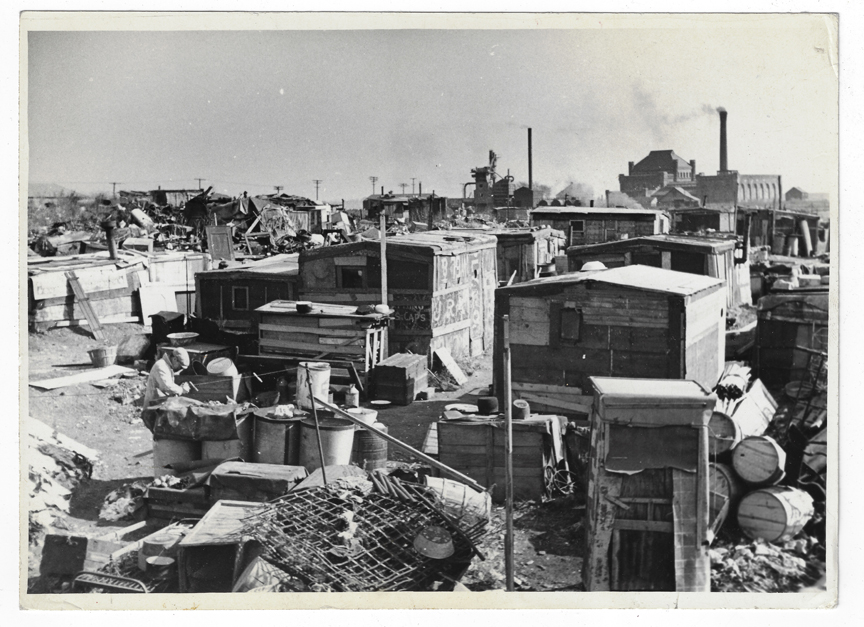
Mile Road Dump in Columbia Point, photographed in 1937. Photo via the Dorchester Historical Society.
Corcoran and his partners, Joe Mullins and Gary Jennison, scored an early success with Queen’s Gate in Weymouth, the first mixed-income housing development in Massachusetts, and one of the first in the nation. Still, the approach had not been tried at a large federal housing project. For that, Corcoran cast an eye on his old hometown.
Clinging to the edge of Dorchester, the fifty-acre spit of land was called Calf Pasture, because that’s what it was, long ago. By the mid-20th century, the site hosted a sewage pumping station and a garbage dump. When the Columbia Point project was erected there in 1954, its 1,500 units across uniform boxes of three and seven stories were supposed to be the last word in public housing.
Within a couple of decades, three quarters of the units were boarded up, and the remaining tenants mostly hid in their apartments to avoid roving street gangs. Neither cabs nor ambulances dared enter the project without police escort.
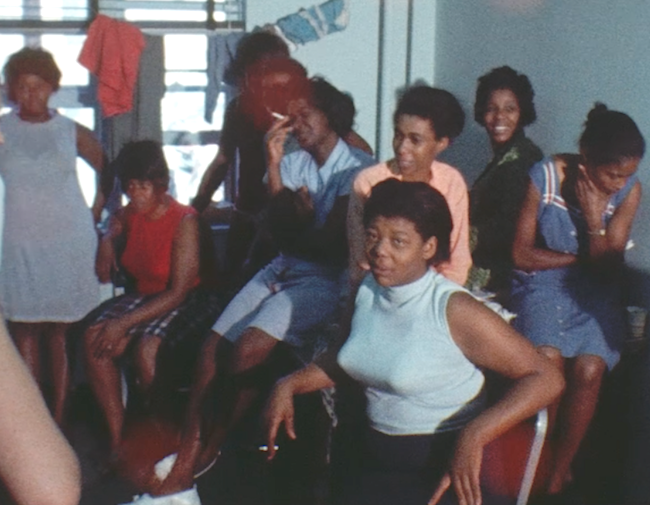
Tenants gather at a community space at the Columbia Point housing project. Photo via WGBH.
Over several years, Corcoran and his team met with resident leaders—the folks who cared about the community. When these white men in business suits outlined their vision for demolishing the projects and enticing market-rate tenants with the site’s ocean views, the mostly poor black women who showed up to the meetings were skeptical. But Corcoran was offering a partnership—the tenants’ task force would be included in all decision-making—as well as a guarantee that a third of the units would be reserved for low-income residents, with no material difference in the quality of the housing across the development.
The task force was sold on the concept, and in 1980, the city leased the property to Corcoran’s company, which razed and replaced the dilapidated, streetless complex with an ordinary, walkable grid of low- to mid-rise apartment buildings and townhouses, as well as shops, tennis courts, and a swimming pool. But would middle-class folks move in to the rechristened Harbor Point? They would and they did. Architect magazine in 2013 reported “an environment in which rich and poor live amicably side by side.”

The outdoor pool at Harbor Point. Photo via Architect Magazine.
Said Corcoran:
Oftentimes people will think I’m ridiculous to try to keep doing something, but I’ve always felt I should hang in there with it and prove that it can be done. And that’s the legacy I might want to leave. If it’s the right thing to do, don’t quit on it.
Seeding the legacy
In 2010, Corcoran—who was a Boston College trustee—returned to the Heights to teach the Real Estate and Urban Action course, with help from Sean McReynolds ’04 and Neil McCullagh ’91, not to mention guest lectures by the late Thomas Menino, then mayor of Boston.
McCullagh explained how he came to work with Corcoran:
I started in the Jesuit Volunteer Corps when I left Boston College. . . . Then I worked for the Olympics for two years, preparing for the 1996 Games at Atlanta. I went back to school to get an MBA, and worked in the tech sector, but I didn’t really enjoy it. What I missed was what had drawn me to the Jesuit Volunteer Corps. I wanted to be focused on people-centered work. That drew me to international development, doing democracy work in Azerbaijan [among other efforts].
After that, I came back to attend the Kennedy School at Harvard on the Ash Fellowship for Innovations in Democracy and Governance. Frankly, I’d planned to return to international work, but we loved being in the Boston region.
That’s when I met Joe [Corcoran]. He said, “I love what you’ve been doing all over the world; why don’t you do that in Boston?”
Initially, McCullagh ran Corcoran’s nonprofit, The American City Coalition, in addition to helping teach the BC course. “I was on the teaching team for Real Estate and Urban Action from the very beginning,” McCullagh says. Then in early 2015, McCullagh was hired as the inaugural director of the new Corcoran Center, under the auspices of the Carroll School. Taylor Perkins joined the following year as assistant director.
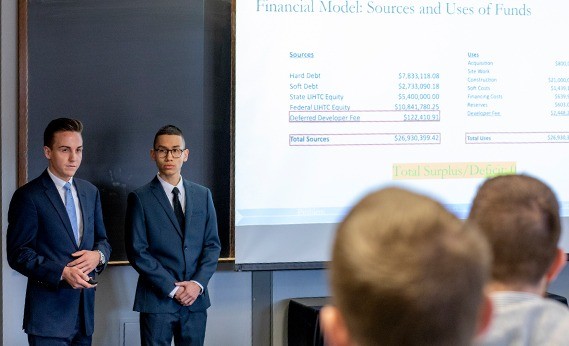
Drew Boland CSOM '19 (left) and Jorge Mejia MCAS '19 presenting in the 2019 Corcoran Case Competition.
In the flagship course, students read Richard Rothstein’s The Color of Law and learn about de jure (legally created) segregation and the impact of housing policy on people of color. They study real estate finance and the history of Harbor Point, meet public housing tenants and industry professionals, and tackle redevelopment simulations using real-life projects as examples. In other Corcoran Center programs, students take part in summer internships, neighborhood engagement, and affordable housing case competitions.
McCullagh explained:
We appeal to their sense of humanity, to their sense of serving the greater good, rather than only thinking about building boxes for people to live in.
We’re also trying to get students out of the, for lack of a better term, the kind of do-gooder, charity mindset, and get them to understand that the way this works—the way to transform these neighborhoods—is by treating everybody respectfully.
We know that housing is one of the critical and cross-cutting tools we have to fight inequality, to fight poor outcomes of health, to fight poor outcomes in education.
This semester, we had an outstanding group of kids coming from education, economics, business—a real cross-section of curious, enthusiastic, dedicated students. And the more we can get all of those people to be thinking about how housing can impact all the social determinants of health and access to opportunity, the farther we’ll go in preventing some of the mistakes of the past.
Hearing from the tenants
McCullagh’s students don’t only read about how Corcoran turned around Harbor Point. This past semester, they also heard, firsthand, the struggles and hopes of tenants of a currently crumbling project, South Boston’s Mary Ellen McCormack Apartments, just a mile up the shore from Harbor Point.
“Since heroin came pushing into our community, I would say about 60 percent of the people I grew up with are now in heaven due to drug overdoses,” Kelly Martin told the class in a February visit.
Martin, an officer of the McCormack Task Force, and Carol Sullivan, executive director of the task force, described a once-close-knit neighborhood brought low by gangs, shootings, the drug-addled “walking dead,” syringes and even feces strewn about, and the anxiety and depression suffered by law-abiding residents and grieving mothers. All while the walls crumble, and the pipes clank and bang—when the heat works.
“[Expletive] has got to change here,” Martin told friends when she joined the task force, a formal committee of resident leaders. “We can’t keep living like this. Your voices need to be heard.”
Concerned residents did speak up, through surveys and in meetings with the Boston Housing Authority. They selected a developer to tear down the apartments (in stages) and replace it with a mixed-income community, adding tiered height and density to accommodate market-rate apartments that would subsidize low rents for all the current residents who want to stay.
Just as at Harbor Point, a third of the units will be allotted to low- and middle-income households, with the same amenities available to all, plus new resources such as early-childhood education centers, after-school programs, a health clinic, and senior services, as well as currently-lacking space for shops at street level. These are the same resident needs articulated in case study after case study that Corcoran Center students are assigned to read or explore.
“We’ll finally get some peace of mind,” said Martin, referring to the plans. “And I’m sure a lot of my friends up in heaven are clapping along, saying, ‘It’s time to clean up.’ And if you don’t like the changes, get out. Get a transfer, move out, and keep living the way you want to live. Because we don’t want to live that way no more.”
Full circle
The Real Estate and Urban Action course (which Corcoran taught until around 2014) has already produced several waves of real estate professionals who care about meeting the needs of residents. One of those professionals is Jennifer Corcoran ’13, a development director at the Joseph J. Corcoran Company, the business founded by her father, who is the son of Joseph E. Corcoran.
Jennifer Corcoran virtually visited an April meeting of McCullagh’s class, held via Zoom, and discussed her work on a planned mixed-income development in Chelsea. Just as her grandfather once did on old Columbia Point, she had to reassure tenants of the existing project that “nobody is getting kicked out,” she said. “There’s a lot of trust-building that has to happen.”
The younger Corcoran described listening to tenants’ needs as well as the act of imagining “a storyline for a resident’s day” in order to see how best the parts of a project will fit together. She talked about how to negotiate the logic and math problems and the emotional and political pitfalls posed by issues such as parking.
When it comes to balancing all the residents’ needs (not to mention the requirement that a project be financially viable), Corcoran pointed out a truism that her family has long known—that the developer who earns the tenants’ trust is the one who is genuinely on their side:
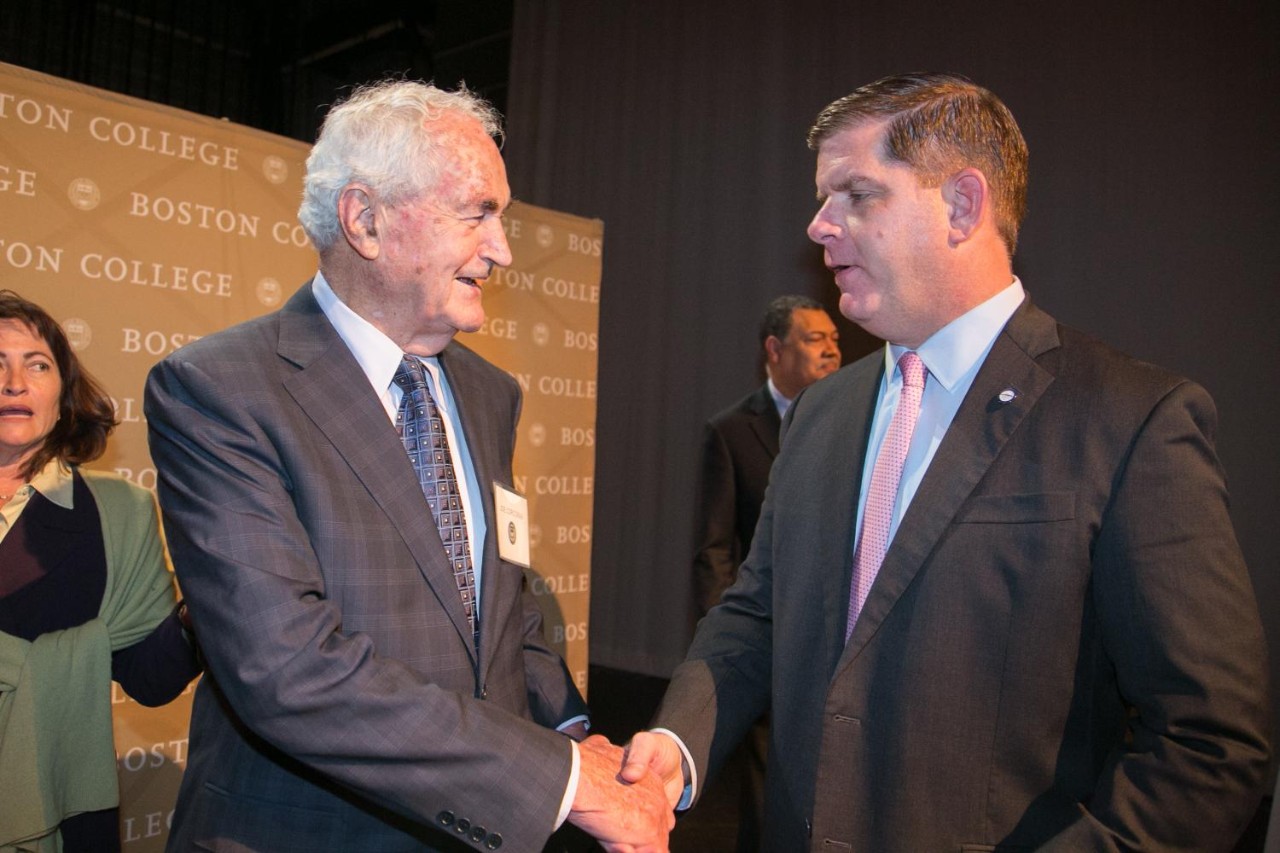
Joseph Corcoran (left) and Mayor Marty Walsh, Woods College ’10, at the Imagine Boston 2030 Forum: “Making Choices for a Growing City” on March 30, 2016.
I think that comes across to people. If you feel passionate about affordable housing, small business, walkability—whatever it is—I think that comes through, and people respect that. If you actually believe what you’re saying, then you’ll figure out a way to convince people of it. Or at the least, you’ll be able to sleep better at night.
Patrick L. Kennedy, Morrissey College ’99, is a contributing writer at the Carroll School of Management.



